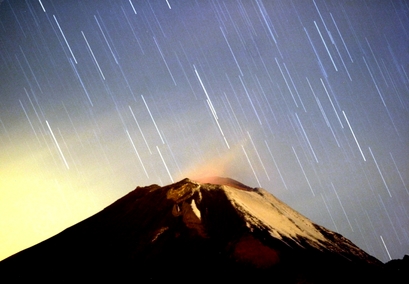CASPER
THE FRIENDLY GHOST


Skywatchers, grab your blankets. December's night sky spectacular will feature the best meteor shower of 2010 as well as the only total lunar eclipse of the year -- sights that should outshine any New Year's Eve fireworks display in terms of sheer wonder.
The massive Geminid meteor shower returns every year, so you'll have more chances if the cold proves too daunting on the night of Dec. 13. But anyone in North America who skips the total lunar eclipse on the night of Dec. 20 will be missing what promises to be the best lunar eclipse show until April 2014.
[Local guides: The best spots to stargaze in your area]
This year's Geminid meteor shower is expected to be the best display of so-called "shooting stars" of the year and will peak during the overnight hours of Dec. 13 and Dec. 14.
Dazzling Geminid meteor shower
Like most meteor showers, the Geminids will be at their best after midnight (early on the morning of Dec. 14), when the Earth is heading directly into the meteoroid stream. But some will be visible earlier in the night, on the evening of Dec. 13, because the meteors' radiant (where they appear to originate) is nearly circumpolar, so they will stay in view above the horizon all night.
[See also: Scientists cry foul over NASA 'life form' find]
This sky map shows where to look to see the Geminid meteor shower in the direction of the constellation Gemini. Clear dark skies, of course, promise the best viewing conditions.
Anyone venturing outside should dress much more warmly than normal to prepare for a long night vigil while sitting still.
Don't forget to get comfortable: A lawn chair with a reclining back and a blanket or sleeping bag should keep skywatchers snug — no binoculars or telescope are necessary.
Most meteor showers are caused by fragments of old comets scattered along a comet's orbit. When the Earth passes through a comet's orbit, it sweeps up the fragments, which become visible as bright streaks of light in the atmosphere.
The Geminid shower is unique in being associated not with a comet, but with an asteroid called 3200 Phaethon.
The Geminids' radiant is, as the name implies, in the direction of the constellation Gemini, just north of the northernmost of Gemini's two brightest stars, Castor and Pollux. In the early evening of Dec. 13, the radiant is low in the northeast. By 1 a.m. EST, after the date has changed to Dec. 14, the radiant is almost directly overhead. By 6.a.m. EST, when the shower is at its peak in the Eastern Time Zone, the radiant is low in the west.
Moon's holiday treat
The December holiday sky show doesn't end with the Geminid meteor shower. On the nights of Dec. 20 and Dec. 21, parts of four continents will be treated to a total eclipse of the moon — the only one to occur in 2010.
